Ever wondered how to have fresh herbs all year without a garden? Indoor herb gardening is fun and rewarding. It adds flavor to your cooking. With the right tips, anyone can grow their favorite herbs indoors. Start by learning about the best herbs and how to grow them indoors. Check out indoor herb gardening guides for more information.
Indoor herb gardening has many benefits. You get fresh herbs all year, better air quality, and natural beauty in your home. Learning the basics, like the best herbs and how to grow them, helps create a thriving garden. This brings joy and freshness to your cooking.
With indoor herb gardening, you can enjoy herbs like basil, chives, and parsley. These are great for indoor growth. Follow the right tips to ensure a bountiful harvest and a beautiful addition to your home.
Introduction: Why Grow Herbs Indoors?
Growing herbs indoors gives you fresh, flavorful herbs all year. With the right care, you can grow many herbs indoors. This includes herbs that love moisture, like basil, and those that prefer dry soil, like chives and thyme.
Key Takeaways
- Indoor herb gardening is a fun and rewarding way to add fresh flavor to your cooking
- The best herbs to grow indoors include basil, chives, parsley, and thyme
- How to grow herbs indoors requires understanding the basics of light, temperature, and watering
- Indoor herb gardening offers numerous benefits, including year-round access to fresh herbs and improved air quality
- With the right tips and tricks, anyone can create a thriving indoor herb garden
- Understanding the best practices for indoor herb gardening, such as fertilization and pruning, is essential for a bountiful harvest
- Indoor herb gardening can be done with smart indoor gardening systems like AeroGarden and Click and Grow
Introduction: Why Grow Herbs Indoors?
Growing herbs indoors has many benefits. You get fresh herbs all year, save money, and add greenery to your home. With indoor herb garden ideas, you can make your garden fit any space. This improves your home’s look and air quality.
When caring for indoor herbs, think about the light they need. Most herbs need 6 hours of direct sunlight a day. But, some like mint and thyme can do well in west-facing windows. If you don’t have much natural light, low-light herbs for indoors are a good choice.
Some popular herbs for indoor gardening include:
- Basil
- Mint
- Parsley
- Thyme
By taking good care of your herbs and trying different indoor herb garden ideas, you can enjoy fresh herbs all year. Whether you’re looking for low-light herbs for indoors or want a lush indoor garden, there are many options.
With the right techniques and knowledge, you can make a beautiful and useful indoor herb garden. It will meet your needs and make your home better.
Choosing the Right Herbs for Indoor Gardening
When picking herbs for your indoor garden, think about a few things. For a kitchen windowsill, basil, mint, and parsley are great. They’re easy to grow and perfect for beginners. With the right setup, you can have fresh herbs all year.
Beginners should start with basil, chives, and cilantro. They’re easy to care for and grow well in many conditions. For a scent-filled garden, try rosemary, thyme, and oregano. They smell wonderful and are great in many dishes.
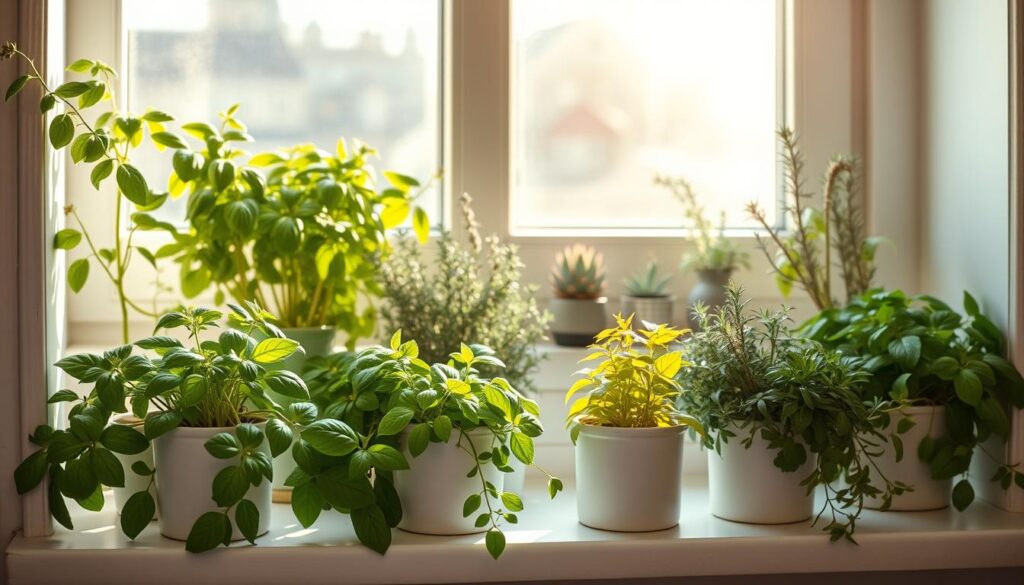
For a full indoor herb garden, consider these herbs. They’re good for cooking, smell great, and are healthy:
- Basil: great for pesto and caprese salads
- Mint: perfect for teas and cocktails
- Rosemary: excellent for roasted meats and vegetables
- Thyme: wonderful for soups and stews
Choosing the right herbs for your garden brings many benefits. You’ll have fresh herbs and a beautiful, fragrant space in your home.
Optimal Indoor Growing Conditions
Creating the perfect environment for your indoor herb garden is key to its success. You need to know the indoor herb garden lighting requirements and the right conditions for your plants. Most herbs need bright light, but some can handle low light. For example, Mediterranean herbs like thyme, rosemary, and oregano do well in partial shade. On the other hand, basil and mint need full sun to partial shade.
Choosing the best soil for indoor herb plants is also crucial. A well-draining potting mix is best for most herbs, as it prevents waterlogged soil and root rot. But, some herbs like mint and chives prefer moist soil, while others like rosemary and thyme prefer dry soil. Knowing the specific soil needs of each herb helps avoid common problems with indoor herbs and solutions like overwatering or underwatering.
Here are some general guidelines for indoor herb gardening:
- Most herbs prefer daytime temperatures between 65-75°F (18-24°C) and nighttime temperatures around 55-65°F (13-18°C).
- Herbs need adequate humidity, typically between 40-60% relative humidity.
- Water herbs when the top inch of soil feels dry to the touch, but avoid overwatering.
By following these guidelines and understanding the specific needs of your herbs, you can create an optimal indoor growing environment. This environment promotes healthy growth and prevents common problems. Always research the specific needs of each herb variety to ensure you provide the best conditions for your indoor herb garden to thrive.
| Herb | Lighting Requirements | Soil Preferences |
|---|---|---|
| Basil | Full sun to partial shade | Moist soil |
| Mint | Partial shade to full sun | Moist soil |
| Rosemary | Full sun | Dry soil |
Containers & Growing Methods
Creating a DIY indoor herb garden in small spaces is easier with the right containers and methods. It’s key to use a well-draining soil and containers with holes for drainage. This prevents soggy soil, which is harmful to herbs. A hydroponic system is a great choice for a controlled environment where your herbs can flourish.
There are many ways to grow herbs indoors, like vertical gardens and shelving units. These options save space and add beauty to your indoor area. Make sure your container is big enough for the herb’s mature size and has holes for drainage.
These systems make growing herbs indoors easy and hassle-free. They ensure your plants get the right water and nutrients. By picking the best container and method, you can enjoy fresh herbs all year, even in small spaces.
Placement & Space-Saving Ideas
Choosing the right spot for your indoor herb garden is key. The best place in your home can greatly affect your herbs’ health and growth. Look for a sunny area near a south-facing window that gets at least 6 hours of sun a day. This ensures your herbs get enough light to grow well.
If you have little space, vertical gardens and shelving are great options. These ideas help you use your indoor space wisely while enjoying your herb garden. You can try wall-mounted planters or tiered shelving units.
Here are some tips for a thriving indoor herb garden:
- Choose a location with good air circulation to prevent fungal diseases
- Use a well-draining potting mix to prevent waterlogged soil
- Water your herbs carefully, as overwatering can be detrimental to their health
Some popular indoor herb garden ideas include using a hydroponic system or a self-watering planter. These systems help ensure your herbs get the right water and nutrients. By following these tips and using the right equipment, you can have a thriving indoor herb garden all year round.
When caring for indoor herbs, think about each herb’s specific needs. Low-light herbs for indoors, like parsley and mint, do well in low light. By picking the right herbs and giving them the right conditions, you can enjoy a fresh harvest of herbs.
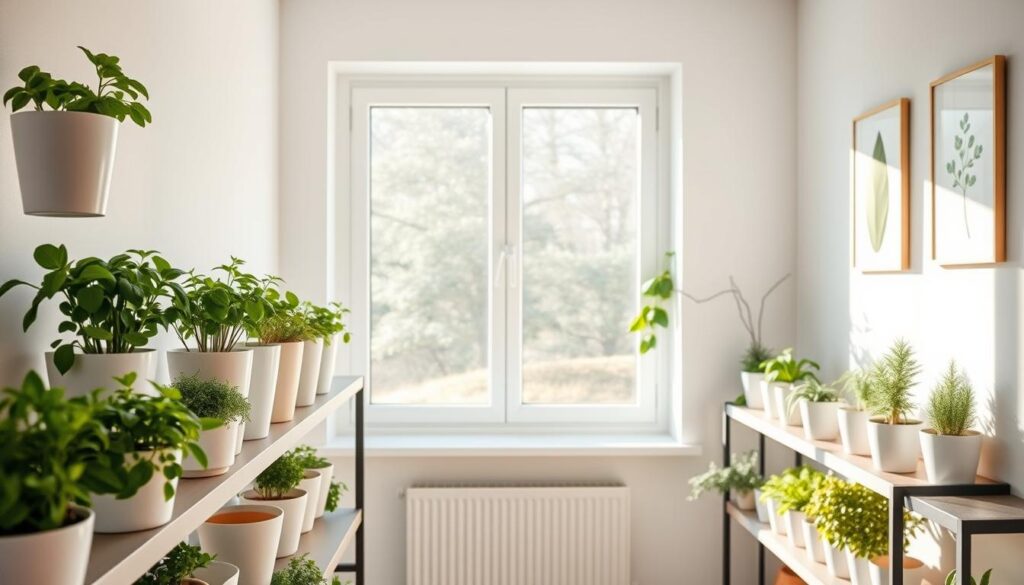
Watering & Feeding Indoor Herbs
Watering and fertilizing indoor herbs is key to their success. Each herb has its own watering needs. For instance, herbs like thyme and rosemary need well-draining soil and careful watering. On the other hand, basil likes moist soil.
Using hydroponic herbs indoors can help. They get a steady supply of nutrients. This is great for growing herbs all year.
Feeding your herbs is also crucial. You should fertilize them once or twice a month. Use a liquid houseplant fertilizer. You can also make your own fertilizer from leftover cooking water. It’s full of nutrients like Nitrogen, Phosphorus, and Potassium.
To keep your herbs healthy, follow these tips:
- Water your herbs when the soil’s surface is dry.
- Fertilize every 2 to 4 weeks, depending on the pot size.
- Choose a balanced fertilizer with N-P-K and other micronutrients.
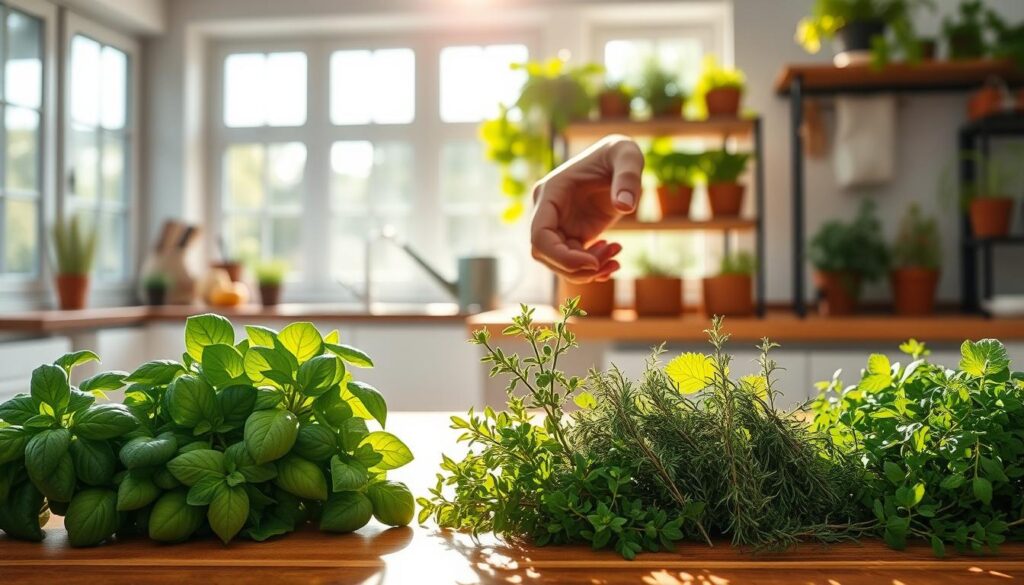
By using these tips, you can grow and harvest your indoor herbs successfully. Enjoy fresh, fragrant herbs all year. Whether you use hydroponics or traditional soil, watering and fertilizing right is essential.
Pruning, Harvesting, and Maintaining Herbs
Pruning is key for indoor herbs’ health and growth. It can boost leaf production by 3-4 times. When you prune, cut off flower buds right away. This stops them from flowering, which can cut down essential oil and flavor by up to 50%.
For top herbs for indoor cooking gardens like basil and mint, pruning keeps them from flowering. It also helps them grow bushy. Easy herbs to grow indoors for beginners such as parsley and thyme need regular pruning too. This keeps their shape and promotes healthy growth.
Some important indoor herb gardening tips and tricks include harvesting herbs in the morning. This helps keep their essential oils and flavor. Also, don’t take off more than one-third of the plant at once. This lets it recover and keep growing. By following these tips, indoor herb gardeners can enjoy a constant supply of fresh, fragrant herbs all year.
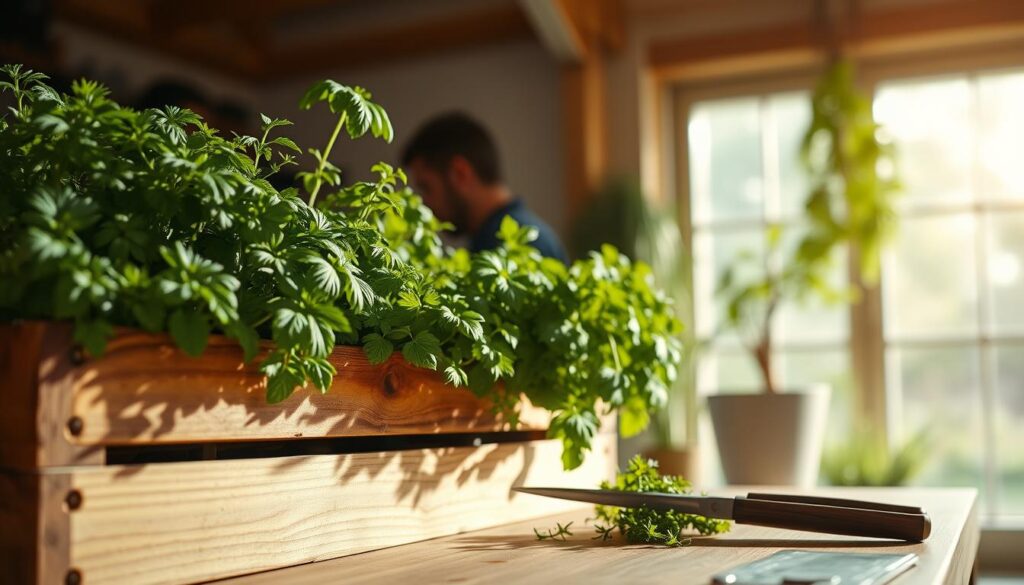
- Harvest herbs just above a leaf node to encourage new growth and maintain plant health.
- Use clean and sharp tools to prevent spreading diseases.
- Regularly inspect plants for signs of pests or diseases and take action promptly if necessary.
Herb Gardening with Pets in Mind
Creating an indoor herb garden means thinking about your pets’ safety. Many herbs can harm pets, so picking pet-safe herbs for indoor gardens is key. Some herbs, like burdock and milk thistle, can help pets. But, garlic is toxic to cats and dogs.
To make a pet-friendly space, research the herbs you want to grow. Make sure they won’t harm your pets. You can also keep herbs out of your pets’ reach or use barriers. Keeping your indoor herb garden clean and healthy during winter is also important to avoid pests and diseases.
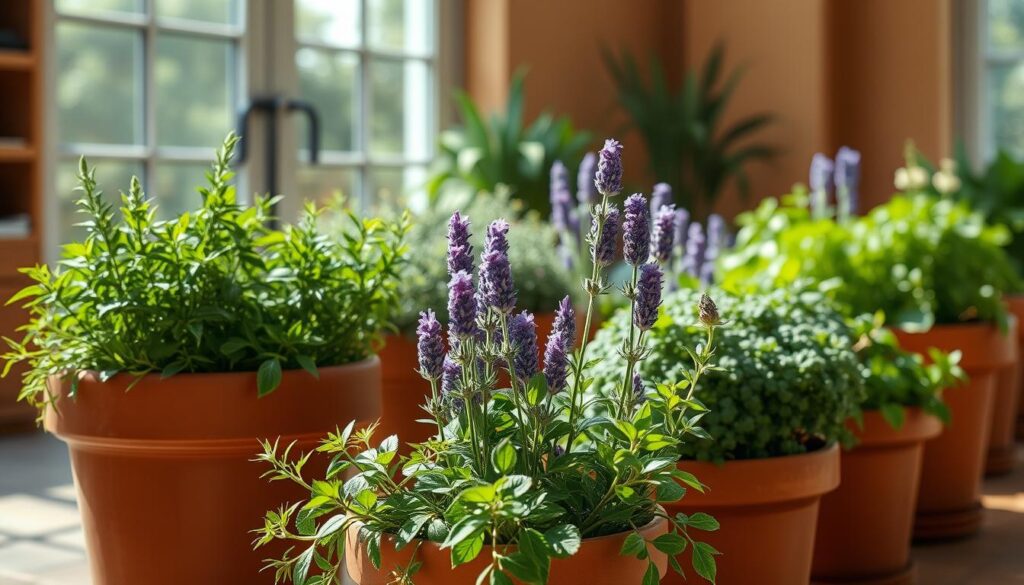
Growing herbs indoors with pets can lead to problems like pests, diseases, and toxicity. Use common problems with indoor herbs and solutions like non-toxic pesticides, regular pruning, and proper watering. These steps help create a safe and healthy indoor herb garden for you and your pets.
Here are some pet-safe herbs you can grow indoors:
- Parsley
- Chives
- Mint
- Basil
These herbs are safe for pets and easy to grow. They can also add flavor to many dishes. By choosing the right herbs and taking precautions, you can enjoy a thriving indoor herb garden.
Year-Round Indoor Herb Gardening
To have fresh herbs all year, you need to know how to grow them indoors. You must understand their light, temperature, and watering needs. Herbs like parsley, basil, and thyme do well indoors with proper care. This lets you harvest them all year. Learn more about indoor herb benefits on trusted houseplant guides.
For winter indoor herb care, ensure they get enough sunlight. If not, use grow lights. Some herbs, like chervil, prefer warmer temperatures. Others, like rosemary, need regular pruning. With the right care, your herbs can thrive through winter.
For a great indoor cooking garden, choose herbs like oregano, sage, and thyme. They’re easy to care for and add flavor to many dishes. Oregano, for example, needs less water than others. A well-drained pot is key to prevent waterlogging. Follow these tips for a lush indoor herb garden all year.
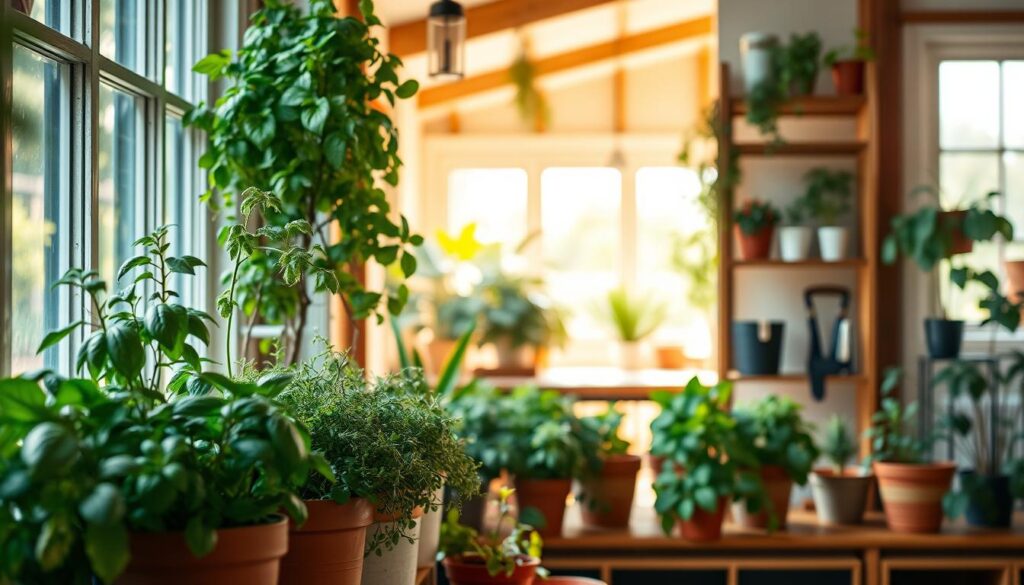
- Providing at least six hours of sunlight daily
- Maintaining temperatures between 65°F and 75°F
- Watering correctly, taking into account the specific needs of each herb
- Using well-drained pots to prevent waterlogging
- Pruning regularly to maintain health and promote growth
By following these tips and choosing the right herbs, you can have fresh herbs all year. This will make your cooking better and add greenery to your home. It makes your home more welcoming and inviting.
Advanced Tips & Companion Planting
For a thriving indoor herb garden, try indoor herb gardening tips and tricks like companion planting. This method pairs herbs that help each other grow. For example, basil and mint work well together.
A smart DIY indoor herb garden in small spaces uses companion planting. It makes the most of your space and helps plants grow well. Try pairing parsley, sage, and chives, or basil, lavender, and rosemary.
If you’re into hydroponic herbs indoors, companion planting is also beneficial. It boosts growth and keeps pests away. By picking the right pairs, your indoor garden will flourish. It will give you fresh flavors and scents all year.
Fast Results: Quick-Growing Herbs
Looking for quick results? There are several easy herbs to grow indoors for beginners that can be ready in just a few weeks. These herbs are great for indoor cooking gardens. They include basil, cilantro, and dill, ready in 3 to 4 weeks.
To get fast results, give your herbs the right conditions. Use well-draining soil and the right nutrients. Also, keep the watering consistent. Indoor herb gardening tips and tricks like LED grow lights help too.
Other easy herbs to grow indoors for beginners are leafy greens like lettuce and spinach. They’re ready in 25 to 30 days. Radishes are even quicker, ready in 20 to 30 days. Follow these indoor herb gardening tips and tricks for a quick harvest.
Troubleshooting Common Indoor Herb Problems
Growing herbs indoors can sometimes lead to issues like yellow leaves, pests, and slow growth. These problems might stem from too much water, too little water, or not enough light. To fix these issues, it’s key to find the main cause and act on it. For example, yellow leaves often mean you’re watering too much. Fix this by changing your watering habits and making sure your pots drain well.
Some common problems with indoor herbs and solutions include:
- Yellowing leaves: Adjust watering schedule and ensure proper drainage
- Pests: Inspect plants regularly and use organic pest control methods
- Slow growth: Provide adequate light and fertilize plants regularly
During winter, indoor herbs might grow slower because of less sunlight. To help, use grow lights or put plants by a sunny window. Also, choose pet-safe herbs like basil, mint, and cilantro for homes with pets. These herbs are safe for pets and add flavor to your dishes.
By following these tips, you can have a thriving indoor herb garden all year. Keep an eye on your plants and act fast if you see any problems. Learning more about indoor herb care and pet-safe herbs will help you keep your garden healthy and safe.
| Common Problem | Solution |
|---|---|
| Yellowing leaves | Adjust watering schedule and ensure proper drainage |
| Pests | Inspect plants regularly and use organic pest control methods |
| Slow growth | Provide adequate light and fertilize plants regularly |
Conclusion: Start Your Indoor Herb Garden Today!
This guide has given you the tools to start a thriving indoor herb garden. It doesn’t matter if you’re new to gardening or have experience. Growing herbs indoors is rewarding and lets you enjoy fresh flavors all year.
By using the tips from this article, you can make your home a lush herb garden. You’ll learn how to pick the best herbs and grow them indoors. This guide has everything you need for a successful indoor herb garden.
So, why wait? Begin your indoor herb garden today. It’s a chance to grow your own herbs and enjoy the benefits of sustainable living. Your cooking, health, and the planet will all benefit.
MORE RESOURCES:
If you are interested in seeing some information on cultivating herbs you can watch Michelle take you through some information on all things plants as well as Herb growing on her YouTube Channel, Gardening TLC.


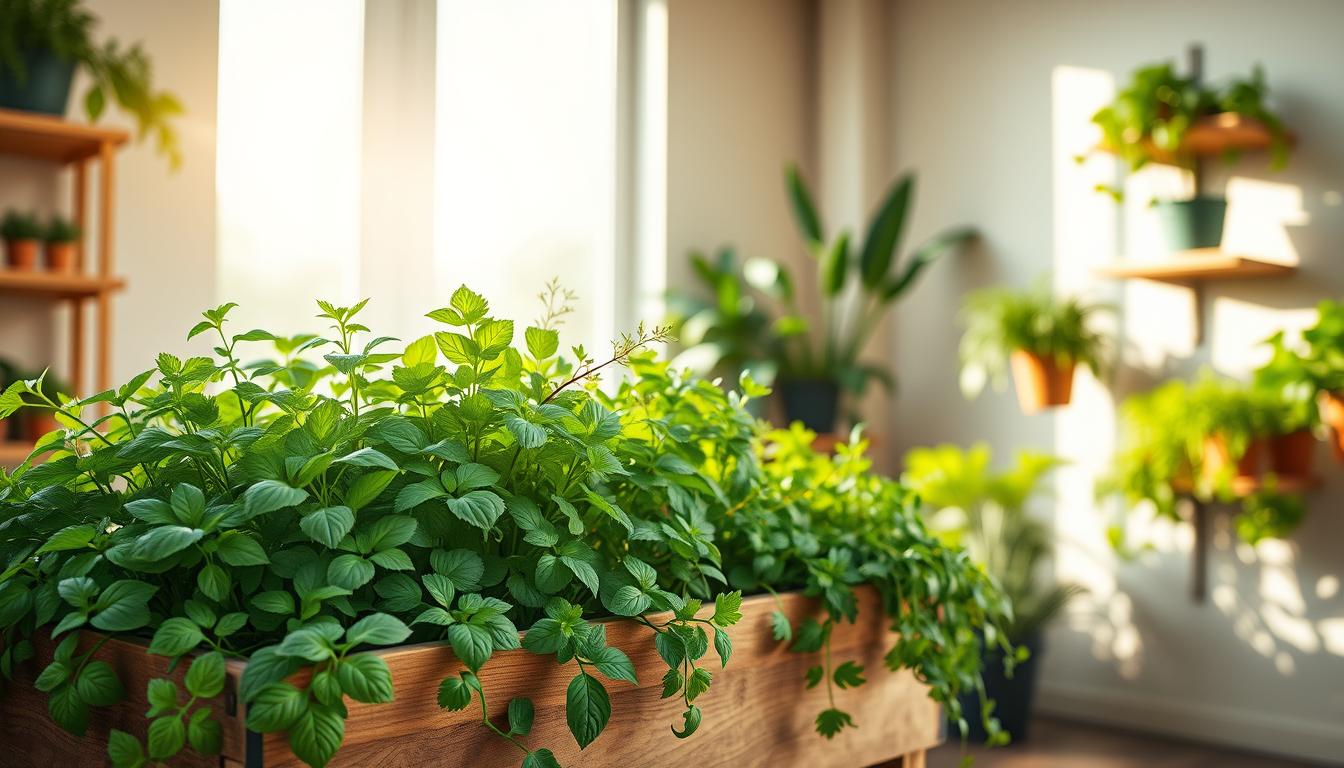
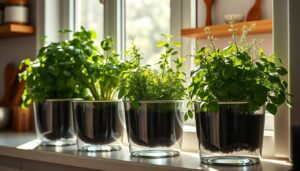
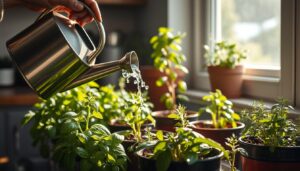
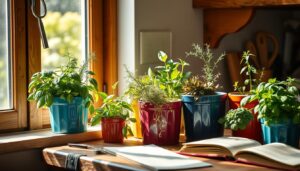
Pingback: Mastering Basil: Growing, Harvesting, and Propagating for Endless Fresh Herbs
Pingback: The Ultimate DIY Indoor Herb Garden Guide: Step-by-Step Instructions